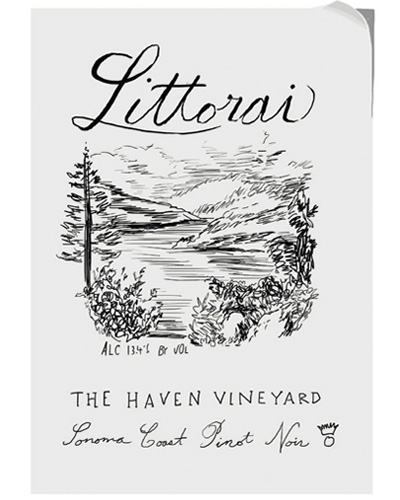We step out of the forest into a glade where light pours through. Ted Lemon has guided me to the top of a hill at 1,200 feet of elevation in The Haven. He has been farming half of this tenacre property since 2001, using biodynamic methods, and he left half of the land wild.
“This is why it’s called The Haven,” he says of Littorai’s estate vineyard. The surrounding forest and coastal scrub provides animal habitat to foster biodiversity. Behind us, pinot noir, chardonnay and chenin blanc grow from a mix of shale, iron sands, compressed clay and serpentine.
These hills are part of Sonoma’s coastal mountains, most of which remain covered in conifers, too steep for cultivation. Vineyards have only arrived in the last 30 years, almost all planted in the 1990s or later on the gentler slopes and hilltops. (Until 1994, when Williams Selyem, Kistler and Littorai came knocking, even David Hirsch’s now sought-after fruit was going to Kendall-Jackson for blending.)
While the massive Sonoma Coast AVA includes plenty of warmer, flatter inland terroir, the region unofficially known as the “west Sonoma Coast” has become a source of bright pinot noir with herbal and earth notes, conifer aromatics and a savory edge, thanks to the rugged terrain and generally cool temperatures.
Lemon was attracted to the area by early examples of pinot from western Sonoma County, wines he tasted in the 1980s. Returning from Burgundy, where he managed Domaine Guy Roulot for two years, he was intrigued by the pinots the Rochioli family had made from its old vines at the western edge of the Russian River Valley at the end of the 1970s, and those Williams Selyem bottled from Summa Vineyard in the Occidental hills. “Williams Selyem’s Summa and Rochioli pinot, these wines stood up,” Lemon says. “They were a personal inspiration for me.”
These Sonoma pinots led him on an exploration of the far coast in Sonoma and Mendocino counties. After eight years, he honed in on The Haven property. During that time, he was among the first to bottle vineyard-designated pinot from sites such as Hirsch, Heintz and Hillcrest.
Lemon was also instrumental in nudging growers toward organic and biodynamic practices. At Hirsch, the organic block they farmed for Lemon proved so successful that they eventually converted the entire vineyard to biodynamic viticulture.
At some sites, where the coastal hills crest above the fog line, the weather can get quite warm, and some producers attain extreme ripeness even at these far-coast sites. Lemon has taken a different direction, coaxing distinctive character from coastal pinot noir—savory wines with backbone and complexity, mouthwatering and saturated with spiced red fruit.
These days, Lemon’s approach to winemaking has begun to seem almost centrist, a steady point around which everyone else orbits. Where producers like Arnot-Roberts ferment their pinot noir as whole clusters and Peay destems, Littorai modifies the technique depending on vintage and vineyard, sometimes completely destemming, sometimes using up to 60 percent whole bunches. While Ross Cobb, at Hirsch and with his own Cobb Wines, makes pinots that are tight and closed on release, Littorai’s tend to show more flesh early on. John Raytek at Ceritas and a few other mavericks aim for racy pinot noirs with sub-13 percent alcohols. Littorai pinots typically come in between 13 and 14 percent. Not that there’s one right answer: All of these producers are making wines that capture the freshness and energy of the coast.
Every year, the critical mass grows, with new producers like Katy Wilson of LaRue, Chris Pittenger of Gros Ventre and Greg Adams of Gregory James joining the relatively older estate wineries (Flowers, Hirsch, Peay) and a few pioneering micro-negociants like Eric Sussman of Radio-Coteau. Taken together, it’s a lineage of producers intent on creating wines that match the beauty of these vineyards in the wilds of the redwoods.
Can You Taste It?


“That’s the one I swallowed,” admitted Josiah Baldivino, drawn to the notes of cola, tea leaf and leather that brought complexity to the fruit. “It has good structure, acidity and not too much alcohol,” he added. With its complete, ripe tannins, it feels like it will take on greater purity with age.
Peay 2012 Ama Sonoma Coast Pinot Noir
Peay makes three estate pinots from their vineyard in Annapolis, near the Mendocino County border: Ama, Scallop Shelf and Pomarium. The Ama strikes the middle ground between the other two, an accessible, friendly pinot. Baldivino described it as a bright wine focused squarely on fruit. It was simple, juicy and quite pretty.
Radio-Coteau 2012 Terra Neuma Sonoma Coast Pinot Noir
The Terra Neuma vineyard faces the Petaluma Gap, a low channel through the hills that brings a daily inundation of coastal fog, a cooling influence that helps the grapes maintain ample acidity as they ripen through a long growing season. Radio-Coteau’s Terra Neuma shows the ripeness the site can attain in a warmer vintage, with lots of wild berry flavor. Baldivino and Becker found it to be pleasurable and dark fruited, a wine that’s already accessible.


The Hirsch Reserve blends the best barrels from the oldest plantings on this iconic vineyard. It’s not the coolest site on the coast, given periodic inundations of warm inland air, but its spare hilltop soils allow the site to grow pinot noir with gravitas. The 2012 Reserve’s stony structure focuses the spice of its oak, while clean acidity keeps its dark fruit lively. Like the Littorai above, it feels balanced to age, though it’s in a more compact form right now.
Ceritas 2012 Hellenthal Sonoma Coast Pinot Noir
John Raytek of Ceritas draws on the Old Shop Block at Hellenthal Vineyard, planted in 1980, dry farmed and own rooted. “I kept going back to the Ceritas,” said Becker. “It has the berry-tone fruit, but also that good acidity and structure I associate with the region.” The raciest of the bunch, Ceritas highlights the cool character of the coastal range with its piercing acidity and chalky tannins.
This story was featured in W&S Fall 2015.
illustrations by Michael Hirshon
Based in Sonoma, Elaine Chukan Brown serves as the American specialist for JancisRobinson.com. Their work also appears in World of Fine Wine, the fourth edition of the Oxford Companion to Wine and on their own site, WakawakaWineReviews.com. Prior to writing about wine, Chukan Brown was a philosophy professor specializing in ethics and social politics.
This story appears in the print issue of fal 2015.
Like what you read? Subscribe today.
















